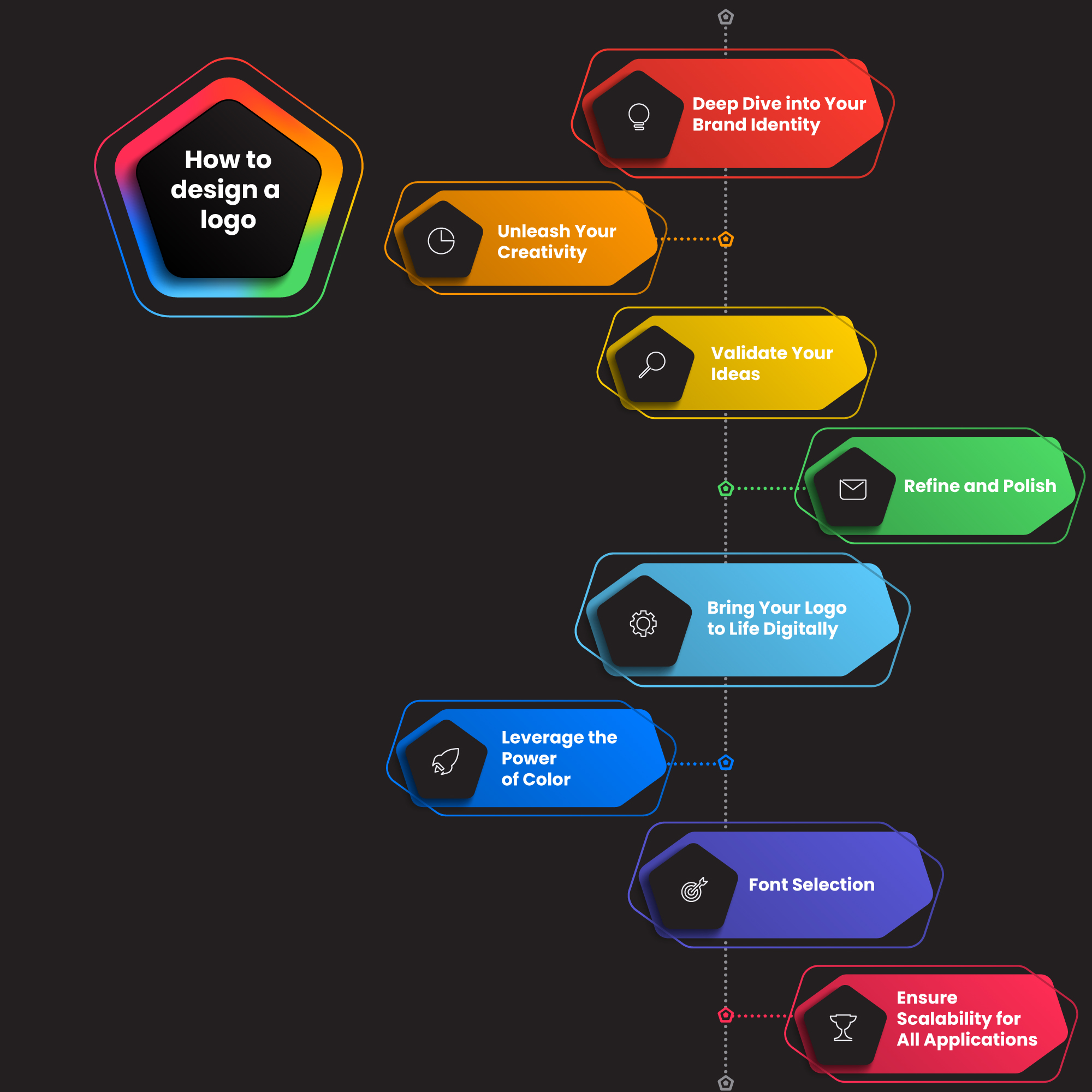How to Design a Logo - Step-by-Step Guide to Logo Design [2024]
![How to Design a Logo - Step-by-Step Guide to Logo Design [2024]](/static/images/blog/large/how-to-design-a-logo.jpg)
Your logo is more than just an image; it's the visual embodiment of your brand. It's the first impression you make, a symbol that captures your essence and resonates with your audience. However, crafting a truly great logo can feel daunting. How do you translate your brand identity into a simple, memorable design?
This comprehensive guide is here to demystify the logo design process. We'll walk you through every step, from understanding your brand to choosing the perfect colors and fonts. By the end, you'll have a logo that not only represents your brand but also sets you apart from the competition. We'll even provide tips for testing and refining your design to ensure it shines across all platforms.
What is a Logo?
So what is a logo...? A logo is the visual cornerstone of your brand identity. It's a symbolic representation, often combining images, text, or shapes, that instantly brings your company or product to mind. Think of it as a handshake in the design world – a memorable first impression that conveys your brand's essence in a simple yet impactful way. Logos can be literal, depicting what you do, or more abstract, evoking emotions or ideas that resonate with your target audience. Ultimately, a well-designed logo is a powerful tool for recognition, building trust, and solidifying your brand in the marketplace.
How to Design a Logo
Your logo is more than just an image; it's the cornerstone of your brand identity. It's the symbol that customers will associate with your company, product, or service. An effective logo can significantly boost brand recognition, trust, and growth. However, designing a great logo takes more than just artistic flair; it requires a strategic approach. Here's a step-by-step guide to help you create the perfect logo.
- Deep Dive into Your Brand Identity:
- Unleash Your Creativity: Brainstorm and Sketch Ideas
- Validate Your Ideas: Test Your Top Sketches with Your Buyer Persona
- Refine and Polish: Hone Your Chosen Sketch
- Bring Your Logo to Life Digitally: Develop Your Logo's Layout on a Design Platform
- Leverage the Power of Color: Pick Versatile Color Options
- Font Selection: Choose a Font that Speaks Your Brand's Language
- Ensure Scalability for All Applications

1. Deep Dive into Your Brand Identity
This is the foundation for everything that follows. Before you even sketch an idea, take time to understand what your brand represents. What are your company's core values, mission, and vision? Who is your target audience, and what emotions do you want to evoke? Brainstorming words that capture your brand's essence (reliable, innovative, playful) can help guide your design direction.
2. Unleash Your Creativity: Brainstorm and Sketch Ideas
Now comes the fun part! Unleash your creativity and explore a variety of logo concepts based on the words you identified. Don't worry about perfect execution at this stage. Sketch freely, experiment with different styles (text-based, symbol-based, or a combination), and explore how visual elements can represent your brand. Think outside the box and consider unexpected elements that could visually communicate your brand message in a unique way.
3. Validate Your Ideas: Test Your Top Sketches with Your Buyer Persona
Remember, your logo isn't just for you; it's for your target audience. Take your most promising sketches and present them to a group of potential customers who represent your buyer persona. Get their feedback on what resonates, what feels right for the brand, and what might be confusing or unclear. This feedback is crucial for refining your ideas. Consider conducting surveys or online polls to gather a wider range of opinions.
4. Refine and Polish: Hone Your Chosen Sketch
Based on the feedback you received, choose the logo concept with the most potential. Now's the time to refine it, focusing on clarity, balance, and memorability. Pay attention to details like spacing, proportions, negative space (the areas between elements), and overall composition. This is where you can elevate your initial sketch into a polished and professional design.
5. Bring Your Logo to Life Digitally: Develop Your Logo's Layout on a Design Platform
Once you're happy with your refined sketch, it's time to bring it to life digitally. There are many free design platforms available online that can help you create a clean, vector-based logo. Here, you can experiment with various color combinations, fonts, and layouts to find the perfect fit for your brand. This is where you can play with different design elements and see how they interact with the logo.
6. Leverage the Power of Color: Pick Versatile Color Options
Colors have a powerful psychological impact and can evoke specific emotions in viewers. Choose colors that not only complement your brand personality but also translate well across different mediums (print, digital, etc.). Opt for color combinations that are easy on the eyes and can be used effectively in various applications. Consider color theory to understand how different colors interact and create a visually harmonious palette for your logo.
7. Font Selection: Choose a Font that Speaks Your Brand's Language
The font you choose plays a significant role in shaping your brand image. Select a font that is both visually appealing and complements the overall design of your logo. Consider factors like readability, style (serif, sans-serif, script), and whether the font reinforces the brand message. For instance, a playful script font might be suitable for a children's clothing brand, while a bold sans-serif font might convey strength and authority for a legal firm.
8. Ensure Scalability for All Applications
Your logo will be used in various sizes, from tiny app icons to large billboards. Ensure your logo design is scalable and maintains its clarity and impact regardless of size. A vector-based logo is ideal for this purpose, as it can be resized without losing quality. This ensures that your logo looks professional and polished in all its applications.
By following these steps and keeping your brand identity at the forefront, you can design a logo that effectively communicates your message, resonates with your audience, and becomes a powerful symbol for your brand. Remember, a great logo is an investment that can serve your company well for years to come.
Types of Logos
A logo is a cornerstone of brand identity, serving as a visual ambassador that instantly communicates your essence to the target audience. Selecting the most appropriate logo style is a critical decision that can significantly impact brand recognition, memorability, and overall effectiveness. Here, we delve into the most prevalent logo categories, exploring their strengths and applications to guide you toward the perfect visual representation for your brand:
- Emblems
- Pictorial Marks
- Wordmarks
- Monogram Logos
- Abstract Logo Marks
- Mascot Logos
- Combination Marks
1. Emblems: A Timeless Mark of Heritage
Emblems are heraldic in nature, incorporating a symbolic image enclosed within a shape like a crest or badge, often accompanied by the brand name. A classic example is the Harley-Davidson logo, where the iconic wings and shield evoke a sense of power and freedom. Emblems excel at conveying tradition, legacy, and trustworthiness, making them a compelling choice for established institutions and organizations. However, their intricate designs might not translate well to smaller applications.
2. Pictorial Marks: Instant Recognition Through Imagery
Pictorial marks, also known as logo symbols, rely solely on an image or symbol to represent the brand. The Apple logo with its partially bitten apple and the Twitter logo with its bluebird are prime illustrations. Pictorial marks are exceptional for achieving immediate brand recognition, especially if the image is straightforward and memorable. Their strength lies in their visual simplicity, but they might not be as effective in conveying complex brand messages.
3. Wordmarks: The Power of Typography
Wordmarks, or logotypes, place the emphasis squarely on the brand name itself. Through the strategic use of typography, a unique and recognizable logo is crafted. Coca-Cola's flowing script and FedEx's bold typeface are exemplary cases in point. Wordmarks are ideal for brands with short, catchy names and boast excellent legibility across various mediums. However, for brands with lengthy or intricate names, wordmarks might pose a challenge in terms of memorability.
4. Monogram Logos: A Space-Saving Approach
Monogram logos, a variation of wordmarks, utilize initials or abbreviated versions of the brand name. These can be seen in the likes of NASA's interlocking "N" and "SA" or the ubiquitous Chanel logo with its double "C." Monogram logos are space-saving solutions that work well for brands with longer names. While they offer a sleek and sophisticated aesthetic, their effectiveness in establishing brand recognition, particularly for lesser-known entities, might be limited.
5. Abstract Logo Marks: Evoking Emotions Through Non-Representational Forms
Abstract logos employ non-representational shapes or symbols to convey a brand message or feeling. The iconic Nike swoosh and the Pepsi logo with its concentric circles are prime examples. Their strength lies in versatility, allowing them to evoke emotions or ideas associated with the brand. However, establishing a clear brand association with an abstract logo might require more time and effort from the audience.
6. Mascot Logos: Cultivating Friendliness with Illustrated Characters
Mascot logos leverage an illustrated character to personify the brand. The Michelin Man and the Pringles mascot are widely recognized examples. Mascot logos excel at creating a friendly and approachable brand image, making them particularly effective for businesses targeting families or children. However, they might not be suitable for all brand personalities and can be challenging to design effectively to resonate with the target audience.
7. Combination Marks: A Strategic Blend of Elements
Combination marks, as the name suggests, strategically combine two or more of the aforementioned elements – text and symbol, symbol and mascot, and so on. Lacoste's logo featuring the crocodile alongside the brand name and Starbucks' siren with the wordmark are illustrative examples. Combination marks offer greater flexibility in communicating a brand message and can be highly impactful. However, ensuring a cohesive and well-balanced design amongst the various elements requires careful consideration during the creation process.
Selecting the optimal logo style hinges on your brand identity, target audience, and the message you wish to convey. By carefully appraising the strengths and limitations of each category, you can make an informed decision that lays the foundation for a powerful and enduring visual representation of your brand.
Logo Design Best Practices
1. Embrace Simplicity: Clarity is Paramount
Effective logo design prioritizes clarity and conciseness. Strive for a clean, uncluttered aesthetic that effectively communicates your brand identity. The objective is for viewers to instantly comprehend and retain the essence of your brand upon encountering your logo. Consider the enduring impact of the Nike swoosh – its simplicity has cemented its iconic status for decades.
2. Ensure Versatility: Adaptability Across Platforms
A well-designed logo transcends a single application. It should seamlessly adapt and maintain its impact across diverse mediums and backgrounds. Imagine utilizing your logo on a business card, a large billboard, and even a miniature app icon. Will it retain its legibility and memorability in each scenario? Test your logo against various colored backgrounds to confirm sufficient contrast and visual impact. Developing alternate color palettes can also enhance your logo's versatility, ensuring its effectiveness in different contexts.
3. Target Audience Alignment: Design with Empathy
Your logo should not only embody your brand's essence but also resonate with your target audience's perception of your brand. Understanding your buyer persona is critical in this regard. Conduct thorough research into their demographics, interests, and visual preferences. By incorporating these insights, you can design a logo that fosters a connection with your target audience and effectively communicates your brand message.
4. Achieve Distinction: Fostering Brand Uniqueness
In today's saturated market landscape, differentiation is paramount. Your logo should possess originality and avoid resorting to generic design elements or overused symbols. Conceptualize your logo as a brand standard – it should project a distinct and memorable identity, separate from your competitors. Eschew cliché symbols or generic design elements that fail to capture attention. Remember, a forgettable logo gets lost in a sea of mediocrity.
5. Cultivate Timelessness: A Design Built to Endure
A truly exceptional logo transcends fleeting design trends and achieves a timeless quality. While attaining iconic status like Coca-Cola's logo may be uncommon, striving for a design with lasting relevance is a commendable objective. The key to timelessness lies in avoiding trendy design elements with a guaranteed expiration date. Instead, prioritize a classic and uncluttered design that will comfortably represent your brand for years to come. Think of it as a timeless suit – it consistently conveys a sense of quality and sophistication, remaining relevant across seasons.
Conclusion
Designing a logo is an exciting journey that allows you to visually define your brand identity. By following the steps outlined in this comprehensive guide and prioritizing clarity, versatility, and target audience resonance, you can craft a logo that not only stands out from the crowd but also leaves a lasting impression. Remember, your logo is an investment that will represent your brand for years to come, so take the time to get it right. And most importantly, have fun with the creative process! To read more about Logo design refer to our previous blog What is Logo Design and How Logo Design Help Your Business.
Hire Python Developers
Hire Python developers who can turn your vision into reality. Hire the most skillfull python developers from Fulllancers.



